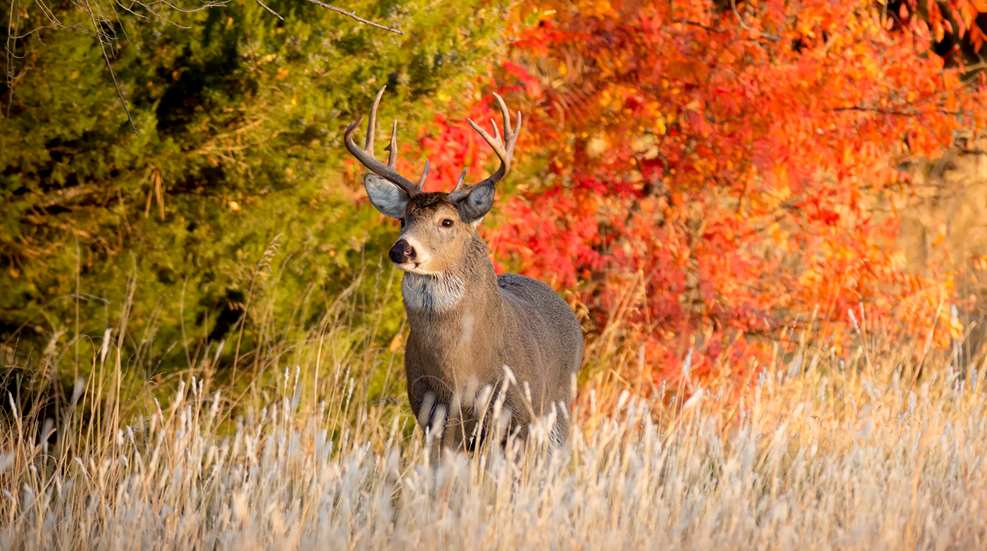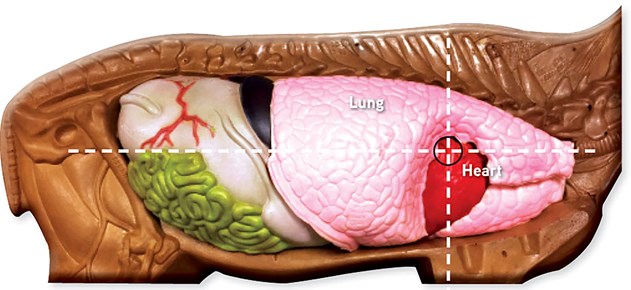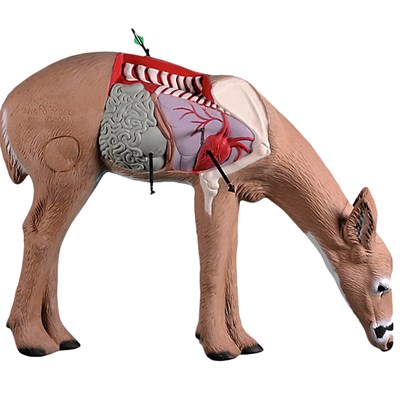
Whitetail deer are the most hunted big-game animal in North America, by a huge margin. They’re not difficult to take down, but as with anything else, shot placement is important. Where should you aim on a deer with a rifle or slug gun?
If the Deer Is Standing Broadside
If a deer is standing broadside to you—that is, so that its entire body is in front of you, with its tail pointing left or right and its head pointing the other way—you have the ideal situation for shot placement. Follow a line up the deer’s front leg to about the middle of the body or slightly lower than halfway, height-wise. A bullet placed in that spot should kill a deer quickly, penetrating the lungs or the top of the heart or both, and maybe breaking the deer’s shoulder so it won’t run as effectively (or at all) with its last few breaths. This is considered by most hunters to be the ideal spot to hit a deer—it doesn’t damage too much meat, it makes for a fast and efficient kill, and it offers a big margin of error. If your bullet drifts off course up, down, left or right by several inches, the deer still dies quickly.

Photo courtesy QDMA
Slightly lower down the body, still in line with the front leg, is an effective aiming spot as well, because that’s where the heart is. About a third of the way up the body is good, but be careful—if your bullet impacts lower than you expected, you could hit the deer in the leg (a non-fatal wound) or miss it completely. Stick with the one-third- to mid-body aiming point.
Many hunters like to aim behind the shoulder, still at that halfway-up-the-body spot but back several inches behind the front leg. This is an effective kill spot and still offers you almost as much margin for error. A projectile aimed here will take out both of the deer’s lungs and encounter little or no bone, which is why this is the preferred aiming spot of many bowhunters. It also should damage very little meat.
If the Deer Is Quartering
Imagine that broadside deer takes a half a turn toward you, so that he’s kind of facing you on a diagonal. You can see his face and some of his body behind him, facing you but at an angle. This is called quartering toward. If a broadside deer takes a half a turn away from you, so you can see his backside and part of his body facing away from you at an angle, this is called quartering away.
A deer quartering away offers a good shot. You still need to hit that general heart/lung area discussed earlier, but you have to get to it from a different angle now. Imagine a line from your muzzle to the deer’s front leg that’s farthest away from you. Where that line hits the body is where you want to aim. It’ll be somewhere behind the shoulder on your side of the deer. If the angle is steep, like the deer is almost facing directly away but quartering just slightly, this shot might take the bullet through the stomach to get to the vitals and front leg. That can be dicey depending on your caliber, and a bullet through the stomach will make for a messy, smelly field-dressing job. If you have any doubts, wait for a better angle.
If a deer is quartering toward you, again, think about where that vital zone is. Aim on or in front of the shoulder closest to you so that the bullet will pass through that heart/lung area. Quartering away is preferred to quartering toward, so keep that in mind.
 If the Deer Is Facing You or Directly Beneath You
If the Deer Is Facing You or Directly Beneath You
This is not an ideal situation, and if you think you’ll get a better angle by waiting, do so. But a deer facing you head-on, as in the case of one walking or feeding right toward you, can be effectively killed with a shot to the vitals if your caliber isn’t too small. Wait until he lifts his head up and exposes his chest, then aim where his neck meets his chest, right in the middle. A bullet placed here should penetrate through to the heart/lung/aorta area. (Photo courtesy Rinehart Targets)
A deer directly below you, as in the case of one walking right underneath your treestand, can be killed by a shot straight down between the shoulder blades, hitting that vital zone. But if he’s beneath you moving slowly enough for you to take this shot, I’d recommend just waiting until he’s a little farther out and presenting a broadside or quartering shot.
Shots to Avoid
You’ll hear hunters brag about all of the following shots, but that doesn’t make them a good idea.
Neck shots: People say they waste almost no meat, and that’s true. But this is a pretty small aiming point, and a margin for error this small leads to wounded deer. Neck shots aren’t a definite don’t-do, but you need to be sure the center of the neck really is exactly where you think it is before you pull the trigger. Better yet, just wait for a better angle.
Head shots: Same as neck shots, but even harder. The brain is an extremely small spot to aim for, and a miss by an inch or less can lead to a horrifying facial wound that will kill the deer via starvation or infection over a period of weeks. It only takes the slightest wind or the tiniest movement of the deer’s face to make you miss a brain shot. Don’t try it.
Spine shots: Aiming high on a deer’s body trying to hit the spine is a fool’s errand. It ruins some of the best meat, for one thing, and if you have the angle for a spine shot, you almost certainly have the angle for a better shot to the vitals.
Texas heart shot: A deer walking away from you presents what hunters call the “Texas heart shot.” From this angle, the right kind of bullet from the right caliber rifle aimed below the tail can send a bullet all the way through the body and into the vitals. I say “can” because all sorts of weird things can happen to a bullet when it has to traverse that much tissue. If the bullet does make it to the vitals and kill the deer, you are in for the most disgusting field-dressing job of your life.
Unsafe shots: As always, follow the gun safety rule “be sure of your target and what’s beyond it.” You must know your safe lanes of fire. If you’re in farm country, don’t shoot toward the direction of any buildings. If you’re spot-and-stalk hunting in hilly country, don’t shoot at an animal that’s skylined—you’ll be sending a bullet into the sky with no way to control where it comes down. And lastly, be aware of other animals when you’re taking your shot. If a buck is milling around among a group of does, make sure he is clear of them before you take aim, or you could end up shooting the wrong animal or shooting two animals with one shot.














































